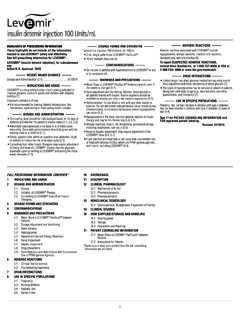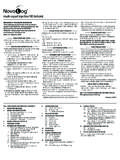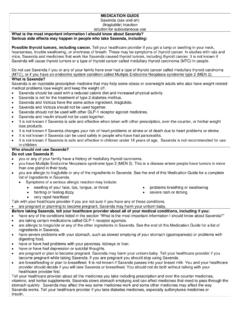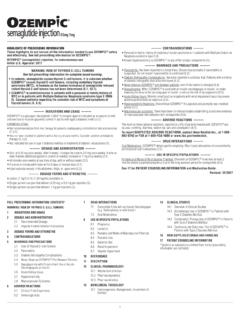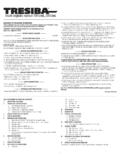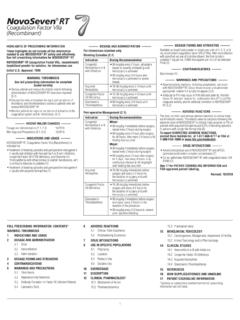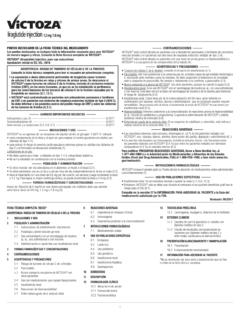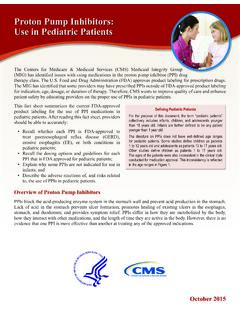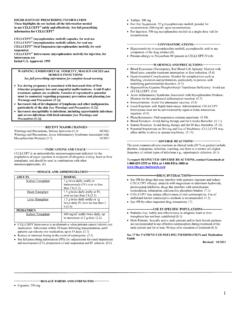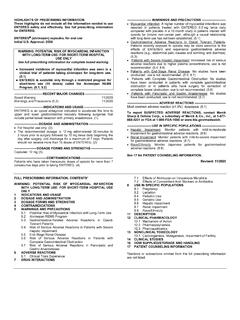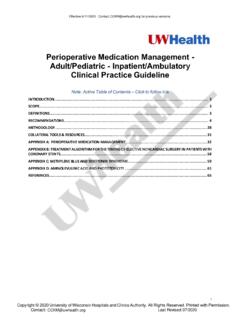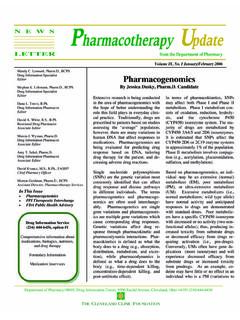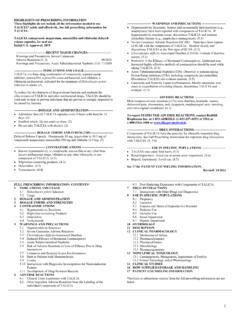Transcription of HIGHLIGHTS OF PRESCRIBING INFORMATION ——— …
1 HIGHLIGHTS OF PRESCRIBING INFORMATION Hyper- or hypoglycemia with changes in insulin regimen: Carry out under close medical These HIGHLIGHTS do not include all the INFORMATION needed to use TRESIBA safely supervision and increase frequency of blood glucose monitoring ( ). and effectively. See full PRESCRIBING INFORMATION for TRESIBA . Hypoglycemia: May be life-threatening. Increase monitoring with changes to: insulin dosage, TRESIBA (insulin degludec injection), for subcutaneous use co-administered glucose lowering medications, meal pattern, physical activity; and in patients Initial Approval: 2015 with renal impairment or hepatic impairment or hypoglycemia unawareness ( , , ).
2 Hypoglycemia due to medication errors: Accidental mix-ups between insulin products can occur. RECENT MAJOR CHANGES Instruct patients to check insulin labels before injection. DO NOT transfer TRESIBA into a Dosage and Administration (2) 03/2018 syringe for administration as overdosage and severe hypoglycemia can result ( ). INDICATIONS AND USAGE Hypersensitivity reactions: Severe, life-threatening, generalized allergy, including anaphylaxis, can occur. Discontinue TRESIBA , monitor and treat if indicated ( ).
3 TRESIBA is a long-acting human insulin analog indicated to improve glycemic control in patients 1 year of age and older with diabetes mellitus (1). Hypokalemia: May be life-threatening. Monitor potassium levels in patients at risk for hypokalemia and treat if indicated ( ). Limitations of Use: Not recommended for treating diabetic ketoacidosis. Fluid retention and heart failure with concomitant use of Thiazolidinediones (TZDs): Observe for signs and symptoms of heart failure; consider dosage reduction or discontinuation if heart Not recommended for pediatric patients requiring less than 5 units of TRESIBA.
4 Failure occurs ( ). DOSAGE AND ADMINISTRATION ADVERSE REACTIONS . See Full PRESCRIBING INFORMATION for important administration instructions ( ). Adverse reactions commonly associated with TRESIBA are: Rotate injection sites to reduce the risk of lipodystrophy ( ). hypoglycemia, allergic reactions, injection site reactions, lipodystrophy, pruritus, rash, edema In adults, inject subcutaneously once daily at any time of day ( ). and weight gain ( ). in pediatric patients inject subcutaneously once daily at the same time every day ( ).
5 To report SUSPECTED ADVERSE REACTIONS, contact Novo Nordisk at 1-800-727-6500 or FDA at 1 800 FDA 1088 or Individualize dose based on type of diabetes, metabolic needs, blood glucose monitoring results and glycemic control goal ( ). DRUG INTERACTIONS . The recommended days between dose increases are 3 to 4 days ( ). Drugs that may increase the risk of hypoglycemia: antidiabetic agents, ACE inhibitors, See Full PRESCRIBING INFORMATION for recommended starting dose in insulin na ve patients and angiotensin II receptor blocking agents, disopyramide, fibrates, fluoxetine, monoamine oxidase patients already on insulin therapy ( , ).
6 Inhibitors, pentoxifylline, pramlintide, propoxyphene, salicylates, somatostatin analog ( , octreotide), and sulfonamide antibiotics (7). DOSAGE FORMS AND STRENGTHS . Drugs that may decrease the blood glucose lowering effect: atypical antipsychotics, TRESIBA injection is available in the following package sizes: corticosteroids, danazol, diuretics, estrogens, glucagon, isoniazid, niacin, oral contraceptives, 100 units/mL (U-100): 3 mL FlexTouch (3). phenothiazines, progestogens ( , in oral contraceptives), protease inhibitors, somatropin, sympathomimetic agents ( , albuterol, epinephrine, terbutaline), and thyroid hormones (7).
7 200 units/mL (U-200): 3 mL FlexTouch (3). Drugs that may increase or decrease the blood glucose lowering effect: Alcohol, beta-blockers, CONTRAINDICATIONS clonidine, lithium salts, and pentamidine (7). During episodes of hypoglycemia (4). Drugs that may blunt the signs and symptoms of hypoglycemia: beta-blockers, clonidine, Hypersensitivity to TRESIBA or one of its excipients (4). guanethidine, and reserpine (7). See 17 for PATIENT COUNSELING INFORMATION and FDA-approved patient WARNINGS AND PRECAUTIONS labeling.
8 Never share a TRESIBA FlexTouch pen between patients , even if the needle is changed ( ). Revised: 03/2018. FULL PRESCRIBING INFORMATION : CONTENTS* Lactation 1 INDICATIONS AND USAGE pediatric Use 2 DOSAGE AND ADMINISTRATION Geriatric Use Important Administration Instructions Renal Impairment General Dosing Instructions Hepatic Impairment Starting Dose in Insulin Na ve patients 10 OVERDOSAGE. Starting Dose in patients Already on Insulin Therapy 11 DESCRIPTION. 3 DOSAGE FORMS AND STRENGTHS 12 CLINICAL PHARMACOLOGY.
9 4 CONTRAINDICATIONS Mechanism of Action 5 WARNINGS AND PRECAUTIONS Pharmacodynamics Never Share a TRESIBA FlexTouch Pen Between patients Pharmacokinetics Hyperglycemia or Hypoglycemia with Changes in Insulin Regimen 13 NONCLINICAL TOXICOLOGY. Hypoglycemia Carcinogenesis, Mutagenesis, Impairment of Fertility Hypoglycemia Due to Medication Errors 14 CLINICAL STUDIES. Hypersensitivity and Allergic Reactions Type 1 Diabetes Adult Hypokalemia Type 1 Diabetes pediatric patients 1 Year of Age and Older Fluid Retention and Congestive Heart Failure with Concomitant Use of a PPAR Type 2 Diabetes Adult Gamma Agonist Safety Outcomes Trial 6 ADVERSE REACTIONS 16 HOW SUPPLIED/STORAGE AND HANDLING.
10 Clinical Trial Experience How Supplied Immunogenicity Recommended Storage 7 DRUG INTERACTIONS 17 PATIENT COUNSELING INFORMATION . 8 USE IN SPECIFIC POPULATIONS *Sections or subsections omitted from the full PRESCRIBING INFORMATION are not listed. Pregnancy 1. TRESIBA (insulin degludec injection) 2. FULL PRESCRIBING INFORMATION Hyperglycemia or Hypoglycemia with Changes in Insulin Regimen 1 INDICATIONS AND USAGE Changes in insulin, manufacturer, type, or method of administration may affect glycemic control and TRESIBA is indicated to improve glycemic control in patients 1 year of age and older with diabetes predispose to hypoglycemia or hyperglycemia.
